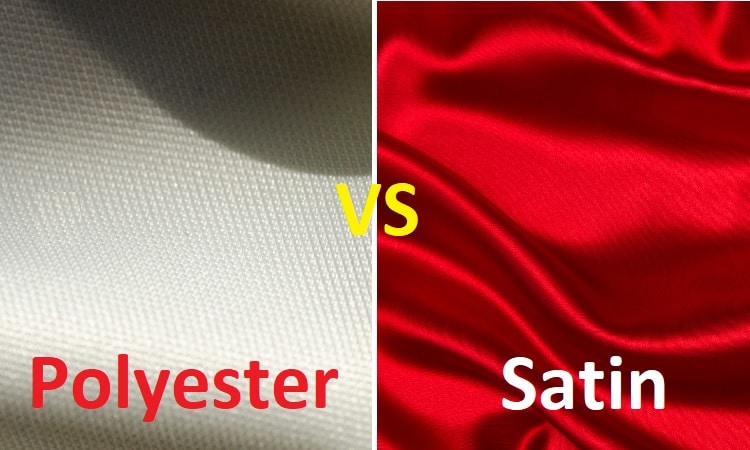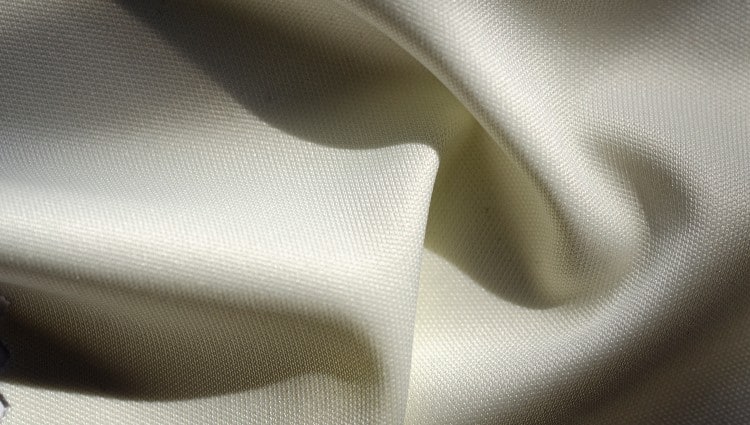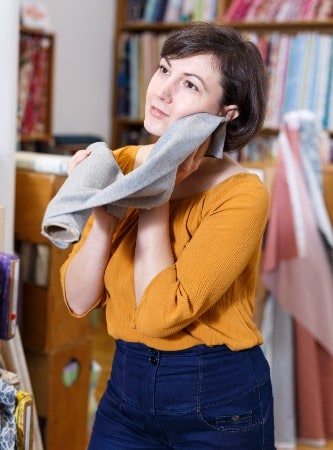Even though they may look very different, polyester and satin are very similar and both have a wide range of uses. Polyester is used for men’s and women’s clothing, sportswear, and bedding. Satin is used for men’s and women’s clothing, accessories, and bedding. Since polyester and satin can both be used for the same things, what is the difference between polyester and satin?
The main difference between polyester and satin is that polyester is a specific type of fiber used to make a fabric and satin is a specific type of weave. Satin is not a fiber itself, rather satin fabric can be made of different types of fibers as long as they are woven together in a certain way.
Polyester fibers are just one type of fiber that is used to make satin. Polyester is a synthetic fiber, so satin made of polyester fibers would be synthetic as well. This is why the two fabrics are very similar. However, there are a few key differences between polyester and satin. In this article, we’ll compare polyester vs satin so that you can decide which one is better for your project.

Polyester vs Satin: Key Points
When choosing between polyester and satin, there are certain characteristics that you will want to look at and compare before deciding which material is the best to use for your project. You will want to compare the following attributes of each fabric:
- Breathability
- Durability
- Softness
- Ease of care
- Cost
- Uses
Considering that both polyester and satin are used for a variety of both women’s and men’s clothing, as well as household items like bedding, it is important to keep the specific use of your project or mind.
As an example, items made out of satin require more care to keep them clean and in good condition. Polyester is easier to care for, meaning that if you want to make something that is going to get used frequently, polyester might be the better choice.
For the most part, the two fabrics are very similar, but there are certain areas where there is a difference between them. This chart offers a brief comparison of some of the characteristics of polyester and satin. Each of these characteristics will be covered in more detail later in the article.
| Polyester | Satin | |
| Breathability | Somewhat breathable | Somewhat breathable |
| Durability | Very durable and shrink-resistant | Type of fiber and proper care determines durability |
| Softness | Stiffer | Softer and silkier |
| Ease of Care | Easy as long as you avoid excess heat | Requires more care, hand wash or delicate cycle only |
| Cost | Inexpensive | Inexpensive if made of polyester |
| Uses | Clothing, sportswear, bedding | Lingerie, scarves/neckties, bedding |
What is Polyester Fabric?

Polyester is a type of fabric that is made of synthetic fibers. These fibers are made of plastic using a mixture of petroleum, water, and other chemicals. Once the fibers are created, they are woven together to create either spun yarn or filament yarn. Then the yarns are woven together to create the fabric.
Individual polyester fibers are very strong. When they are woven together, they create a fabric that is strong and durable as well. However, since they are made of plastic, the fibers don’t have some desirable qualities that natural fabrics such as cotton have. While polyester may not be as soft and breathable as cotton, it is still a relatively soft and breathable fabric considering that it is made of plastic.
The use of polyester for clothing became more popular during the 1970s. It was marketed as an inexpensive fabric that was resistant to stain and wrinkles. The use of polyester has increased even more since then, and it is still a very affordable fabric with a variety of uses.
What is Satin Fabric?
Most of the satin fabric that is in use today is synthetic as well. Satin is not a textile itself, rather it is made of synthetic fibers woven together in a certain way. The way the fibers are woven together gives satin it’s shiny and soft appearance and texture.
Affordable satin fabric is made out mostly out of polyester fibers, but it can also be made out of nylon or acetate. Satin can also be made of silk fibers, but this type of satin will be more expensive since silk is a natural material that can sometimes be pricey.
The fabric itself is created by weaving together polyester, nylon, acetate, or silk fibers using a twill weave process. Weaving the fabric together in this way gives one side a smooth and shiny appearance while the other side looks dull and muted. Due to the affordability and ease of care that polyester offers, satin made from polyester is the most popular choice.
Satin vs Polyester: What’s the Difference?
Breathability
Since polyester is such a widely used fabric, it does have a certain level of breathability. You won’t find polyester as breathable as fabrics made from cotton, linen, or rayon, but it does breathe. The breathability of polyester is enough to make it a good fabric choice for sportswear and bedding. Since both sports and sleeping create a lot of heat retention, you want a fabric with enough breathability to be still comfortable.
Satin fabric has about the same amount of breathability as polyester. Since the fibers are woven more closely together, resulting in a softer fabric, the breathability of satin might be a little less than polyester. Satin that is made from silk fibers may be slightly more breathable than satin made from polyester since silk is a natural fabric. But satin is still breathable enough to make it a good fabric choice for bedding.
Durability
Polyester is one of the most durable fabrics that you can buy. This is because it is a synthetic fabric, so it is made to be durable and withstand many wear and tear. Polyester fabric is stain, wrinkle, and shrink resistant. Items made out of polyester will generally last for a long time as long as you take the proper care with them.
Satin fabric is made up of long filament fibers. The long fibers mean that satin is a strong and durable fabric that doesn’t wrinkle easily, especially if it is made with polyester fibers. Satin that is made with silk fibers won’t be as durable since silk fibers are more delicate. But no matter what satin is made with, the type of weave used to create it and the long filament fibers are the same.
Softness
 One of the negative things about polyester is that since it is a synthetic fabric made of plastic, it can sometimes feel stiff. This is especially true when you first buy it. Polyester is made of long fibers that make it very strong, but in turn, the fibers create a very stiff fabric. The fabric may soften over time with frequent wear and washing. Or, you can buy spun polyester fabric instead, which tends to be a bit softer.
One of the negative things about polyester is that since it is a synthetic fabric made of plastic, it can sometimes feel stiff. This is especially true when you first buy it. Polyester is made of long fibers that make it very strong, but in turn, the fibers create a very stiff fabric. The fabric may soften over time with frequent wear and washing. Or, you can buy spun polyester fabric instead, which tends to be a bit softer.
Because of the way that satin is woven together, the fabric has a texture that is softer and shinier than polyester. It’s the softness and shininess that gives satin the appearance of being a luxury fabric, regardless of whether it is made of polyester or silk. While both sides of satin fabric may feel soft, only one side will have a shiny appearance. So if you choose to use satin for your project, the shiny side must face the outside.
Ease of Care
Polyester
Polyester is a fairly easy fabric to take care of and keep in good condition. The element to avoid when washing and drying polyester is high temperatures. Since polyester is made of plastic, the fibers can melt when exposed to prolonged heat from the washer and dryer. High temperatures should also be avoided when caring for polyester satin fabric since the type of fibers is the same.
Since polyester is mostly stain resistant, you don’t have to worry too much about stains being difficult to remove. The stains that do appear will usually come off in the washing machine. When you do wash polyester fabric, you can wash it on the normal cycle. Wash the fabric in warm or cool water, not hot. After washing, hang polyester to air dry or toss it in the dryer on medium heat.
Satin
Satin requires a little more care to keep it in good condition. If satin is made from polyester, it may resist stains more than stain made from silk. No matter what fiber it is made of, stains will be more noticeable on a shiny fabric, especially grease stains. You should treat any stains on satin fabric as soon as possible to keep them from setting in. Most stains on satin can be treated with a stain remover. Do not use bleach, as it can be too harsh for satin.
When it comes time to wash satin, you should have it dry cleaned if it is made of silk. Silk is a delicate fabric and the washing machine could damage it. For polyester satin, it is best to turn it inside out before you wash it so that you don’t risk damaging the shiny side of the fabric. Hand-washing satin is better, but you can use the washing machine as long as you wash it on the delicate cycle.
When drying satin, it is best to avoid using the dryer. The best way to dry satin is to roll it up in a towel and squeeze out any excess water. Then, lay it flat on a dry towel to air dry. If you need to iron it, place a pressing cloth between the iron and the fabric and turn the iron to the lowest setting. Be sure to store anything made of satin away from windows because it can fade easily in the sun.
Cost
Polyester is one of the cheapest fabrics that you can. Any type of synthetic fabric will be cheaper than natural fabrics because synthetic fabrics can be created. Manufacturers can produce as much as they want and can. This lowers the cost because polyester fabric is more readily available.
The cost of satin largely depends on what it is made of. If satin is made from polyester or another synthetic fabric, it won’t be too expensive, although it may cost a little more than polyester just because of how it is made. The great thing about polyester satin is that it isn’t as expensive as silk but has a similar appearance. Satin that is made of silk fibers is going to be more expensive since silk is a natural fiber.
Uses
No products found.Polyester is mostly used for clothing, particularly t-shirts and sportswear. You can also find household fabrics made of polyester, like bedding, blankets, and towels. Polyester can be used by itself or blended with other fabrics such as cotton or spandex. There are variants of typical polyester that are also used, including spun polyester and microfiber. Spun polyester is often used in outdoor upholstery, while microfiber is used for indoor upholstery, cleaning cloths, and bedding.Satin is usually used to make items seem more luxurious and elegant. The most common uses for satin are women’s evening gowns, lingerie, and blouses. You can also find men’s underwear made of satin. It is also a popular material to use for neckties, scarves, and other accessories. Pajamas and bedding made of satin are also common because of how the fabric feels against the skin.
Pros and Cons of Polyester
Polyester is such a widely used and inexpensive fabric, but it does have pros and cons. To retouch some of the pros, polyester is durable, stain-resistant, and wrinkle and shrink resistant. Other pros of polyester include:
- Moisture-wicking
- Fast-drying
- Shrink/wrinkle resistant
- Easy to care for
Due to its moisture-wicking and fast-drying abilities, we can see why polyester is a great choice to use for sportswear and bedding. These fabrics receive exposure to a lot of moisture, so it is good for them to be made out of a fabric that helps control moisture.
Despite all the great things about polyester, it does have cons. Some of the cons of polyester include:
- Less breathable than natural fabrics
- Somewhat flammable due to being made from chemicals
- Intolerant of high temperatures
- Synthetic, so it is not as sustainable
- Not as soft as other fabrics
Some of the cons on this list limit the use of polyester for people who prefer more natural and sustainable fabrics.
Pros and Cons of Satin
As far as durability, affordability, and resistance to wrinkling, satin is pretty comparable to polyester as long as you care for it properly. However, some of the pros of satin differ from those of polyester. Here are some of the pros that make satin a better choice:
- Feels good against the skin
- Soft
- Looks luxurious
- Inexpensive compared to silk
Satin is arguably more comfortable than polyester because of its softer and smoother texture. The texture of satin feels great against the skin because it has a cooling effect. Even though satin isn’t as breathable as other fabrics, the coolness of the fabric helps to keep it comfortable.
Satin does have cons as well. Most satin fabrics are made of synthetic fibers, which means that satin can also be flammable and doesn’t tolerate high temperatures. Other cons include:
- Requires more care
- More expensive than polyester
- Hard for beginners to sew with
Remember that satin does require more specialized care than polyester, especially if it is made with silk. Silk satin is also more expensive than polyester. Perhaps one of the biggest cons of satin is that no matter what type of fiber it is made of, it is hard for beginners to sew with. This is due to the slippery texture that makes it hard to handle. The delicate nature of the fabric also doesn’t leave much room for error.
Popular Products Made of Polyester and Satin
Polyester Shower Curtain
 Polyester is a great fabric choice for shower curtains because it is moisture-wicking and dries quickly.
Polyester is a great fabric choice for shower curtains because it is moisture-wicking and dries quickly.
This polyester shower curtain from Amazon comes in so many colors and sizes.
Since it is water-resistant, water glides off, meaning you can use it with or without a clear plastic liner.
This shower curtain is also machine-washable.
Polyester Performance Tee
 This performance t-shirt is made from 100% polyester and is great for sports or other active activities.
This performance t-shirt is made from 100% polyester and is great for sports or other active activities.
It comes in many different colors and sizes.
The polyester fabric is moisture-wicking, odor-resistant, and stain-resistant, so it will help keep odors and stains at bay while you exercise.
It can also be machine-washed for easy cleaning.
Satin Sheets
 These satin bed sheets come in sizes ranging from Twin to California King. They can be purchased in 16 different colors.
These satin bed sheets come in sizes ranging from Twin to California King. They can be purchased in 16 different colors.
The sheets are made from polyester satin but are wrinkle-resistant and have a silky, luxurious feel.
If you don’t want the whole set, you can buy just the pillowcases instead.
Satin Scarf
 This satin scarf comes in 45 different styles. It is made of polyester satin and can be used in so many different ways.
This satin scarf comes in 45 different styles. It is made of polyester satin and can be used in so many different ways.
You can wear it as a head or neck scarf, a shawl, or tie it to a purse or handbag.
The scarf is delicate, so it should be hand-washed or dry cleaned.
Conclusion
I hope you found this article helpful for distinguishing between polyester and satin. Remember that polyester refers to a certain type of fiber, while satin refers to a type of weave and can be created using synthetic or natural fibers.
Other than the softness and ease of care of polyester and satin, the two aren’t that different. The texture of satin gives items a more luxurious appearance.
If you enjoyed the article, share it with others and leave a comment. Thanks for reading!
